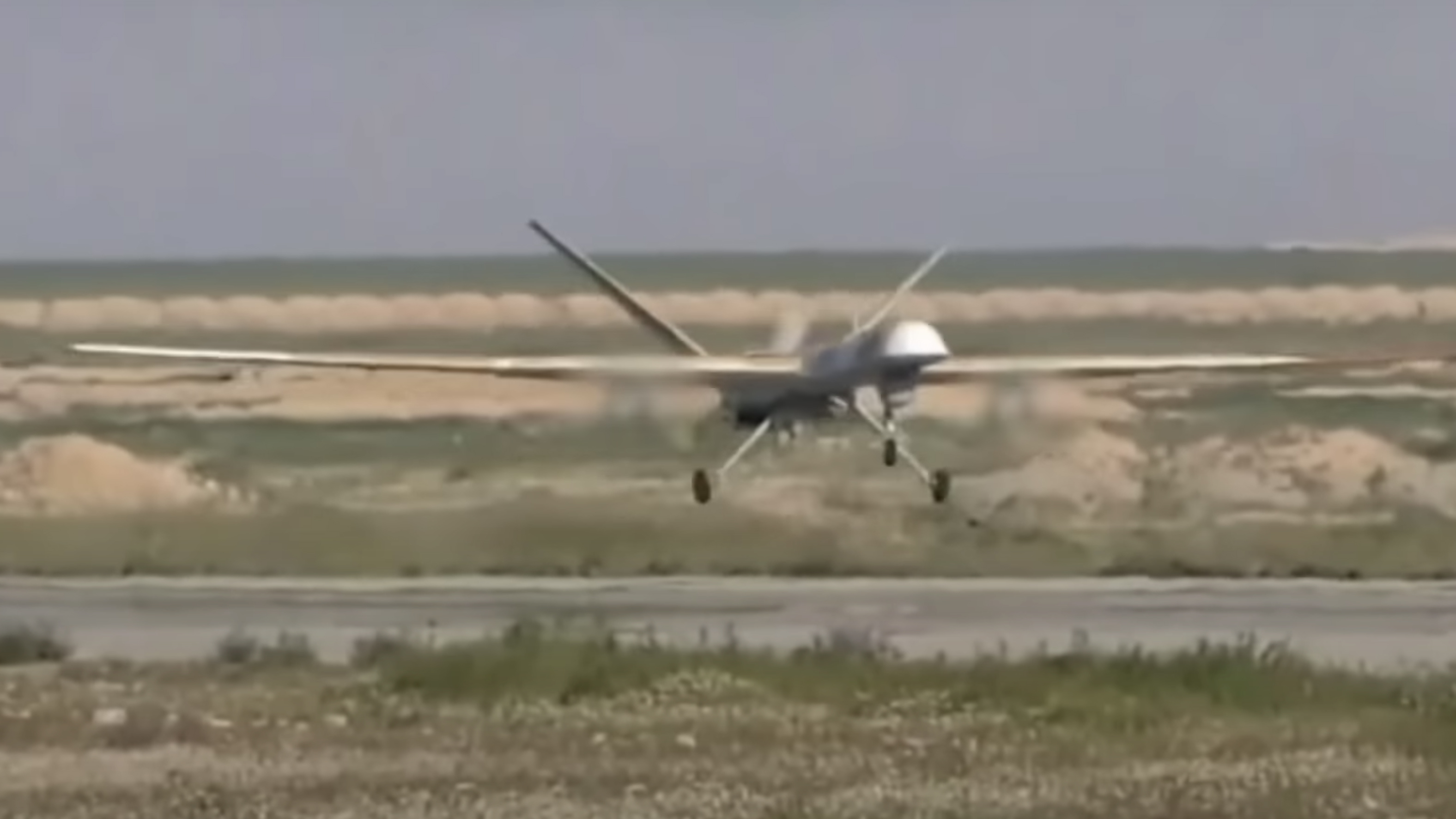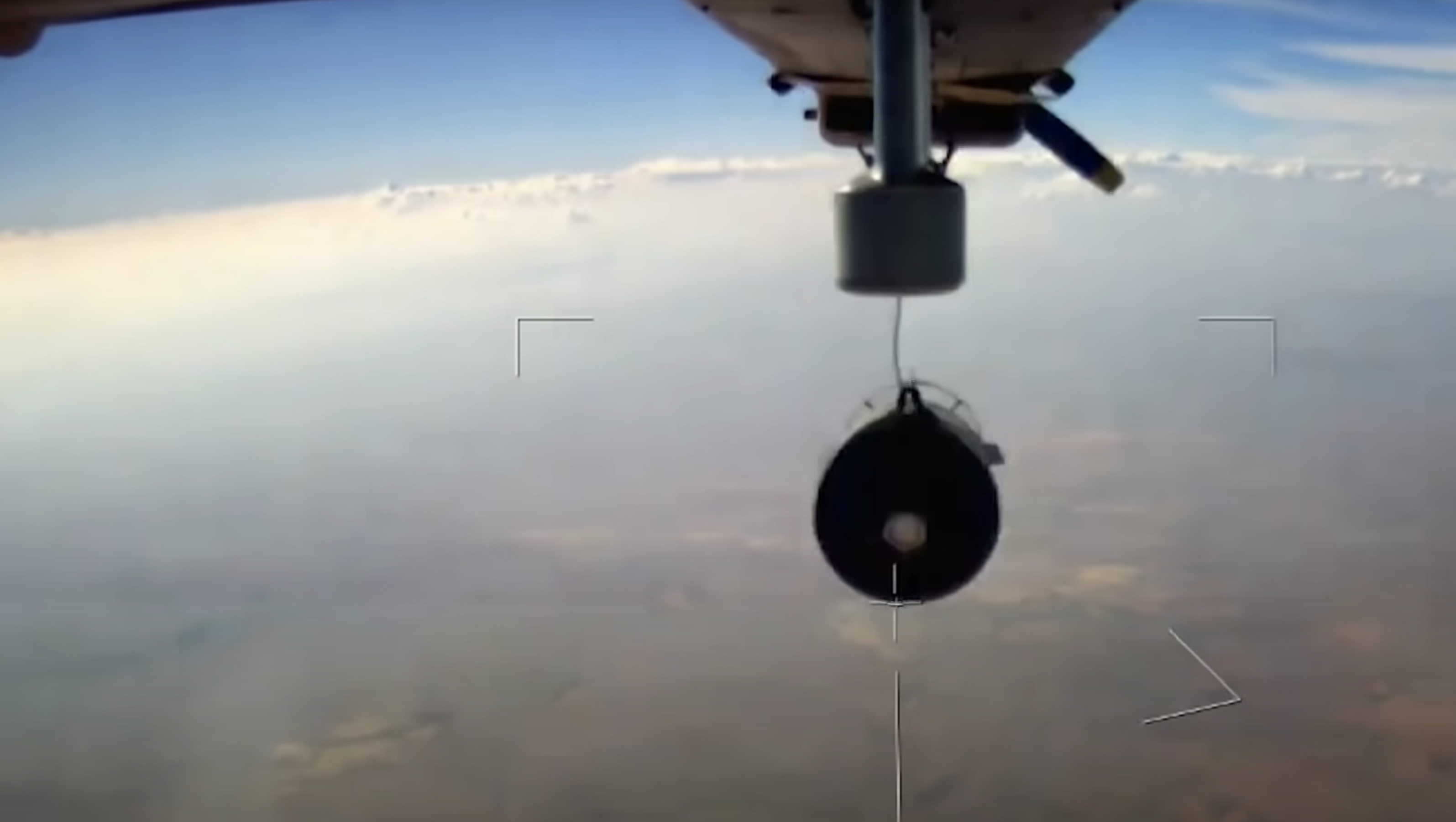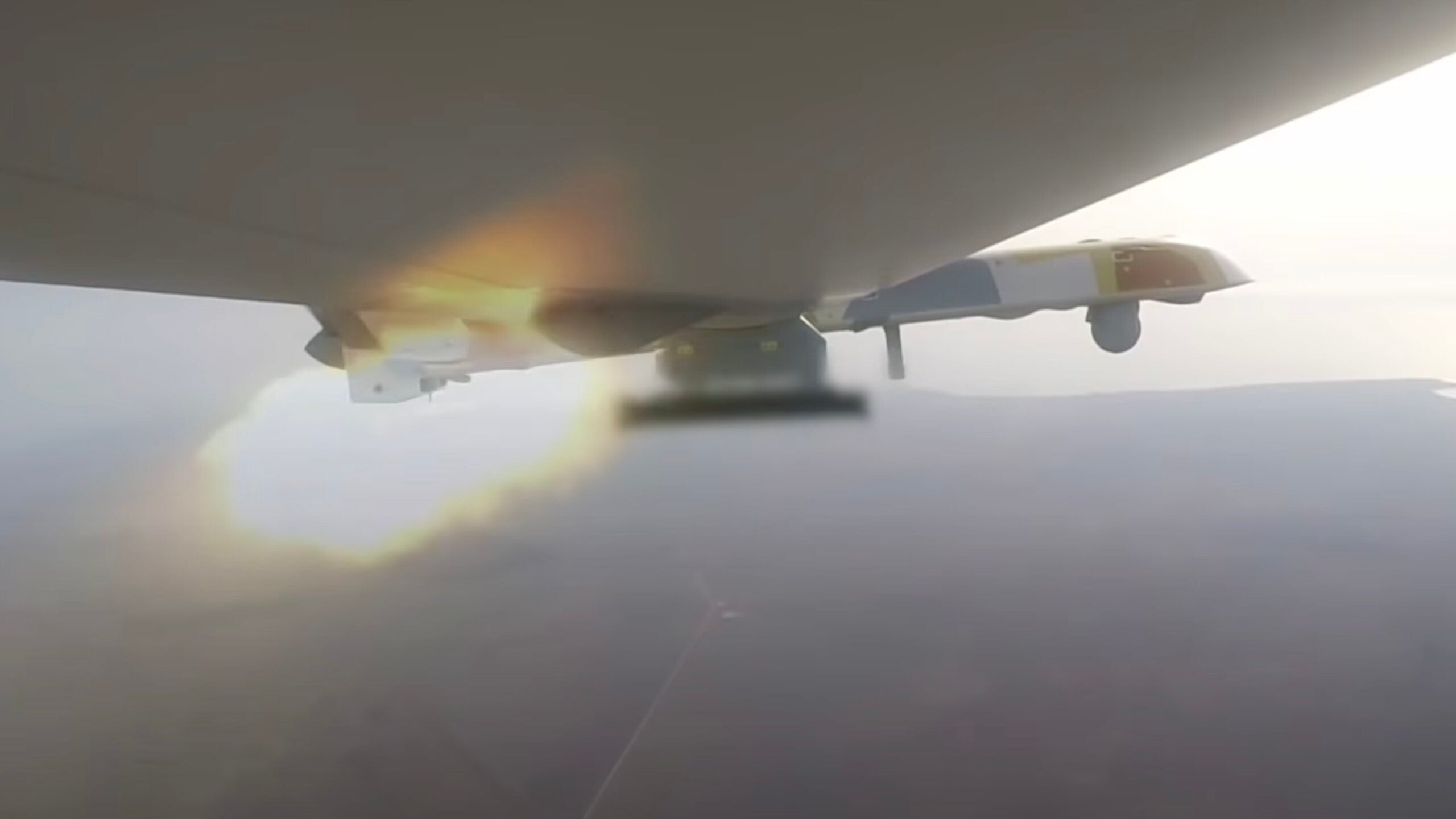Russia has released a video showing, apparently for the first time, its Orion unmanned aerial vehicle during field trials in Syria, including dropping weapons. The footage seems to have originated from the drone’s combat evaluation that reportedly took place in 2018.
The video was shown on Russia’s state-owned Channel One television station yesterday as part of a 12-minute report on the country’s rapidly developing unmanned aerial vehicle (UAV) technologies, including the Orion and the jet-powered Okhotnik. While part of the purported combat sequence shows the Orion carrying four small weapons on underwing pylons, these areas have been deliberately obscured.

The location of the combat deployment is apparently confirmed by footage of an Orion takeoff at Tiyas Air Base (also sometimes known as T-4) in Homs Governate, central Syria. Some of the base’s non-operational MiG-25 Foxbat jets can be seen in the background. In the past, this base has been used as a major hub for Russian rotary-wing operations, since it is closer to the actual fighting than the main Russian airbase at Khmeimim, suggesting that the Orion was forward deployed there to get as much combat time as possible.
Twitter user @obretix has also compared this to more recent imagery of the same base, seemingly confirming that the video was made sometime between December 2017 and early April 2019, which would coincide with the previously reported in-theater trials.
At one point in the video, a reporter points to apparent mission markings on an Orion UAV in a desert-style camouflage, noting that this particular aircraft flew 38 sorties in Syria, where the Russian Aerospace Forces have been active in support of the Assad regime since late 2015. These 38 sorties seem to have comprised 20 for reconnaissance (разведывательных, indicated with the letter R in Cyrillic), 17 for strike (ударов, B in Cyrillic), and one for an unidentified assignment (the letter P in Cyrillic). The Orion has a turret under the nose with electro-optical and infrared cameras, plus a laser target designator to deliver guided weapons. It can also be fitted with additional cameras or a surveillance radar, although there is no evidence that the radar was fitted for the Syrian deployment.

Other footage claimed to have been taken during the Orion missions in Syria includes a sequence in which the drone was said to be locating a “terrorist munitions storage facility,” in cloudy conditions, before releasing a weapon, which reportedly destroyed the target. A night strike sortie is shown too, with video gathered using the drone’s TV and thermal imager. Again, @obretix has geolocated the sites of these apparent drone strikes, including identifying individual buildings in the vicinity of Al-Mukharram, also in central Syria.
The Channel One report mentioned that the Orion can carry laser-guided bombs and other precision weapons. These were described as “still classified,” before an Orion was shown taking off with a weapon underneath, intentionally obscured. Next, the drone seemed to fire a weapon, with the following footage showing an explosion on the ground. From what we can tell, the combination of a burst of flame from the rear of the mounting on launching, and the general shape, suggests some kind of tube-launched guided rocket or lightweight missile.

Elsewhere in the video, an Orion also appears to drop an unguided bomb from a centerline station. From what can tell, the weapon may be a 110-pound-class FAB-50-series weapon. While this is the only unobscured weapon shown in the video, the fact the bomb seems to be unguided would suggest it would only be an accurate method of delivery during clear-weather daylight conditions. However, Russia has made heavy use of unguided munition in Syria, often in an indiscriminate fashion, with these type of weapons far outnumbering guided munitions.

Referring to Orion’s performance in Syria, Sergei Tyugay, deputy head of unmanned aviation within the Russian Aerospace Forces high command, said that it had shown itself to be “not just successful, but survivable.” That claim seems questionable, however, considering that even high-performance manned combat aircraft have proven vulnerable to rebel groups in Syria. Drones in the class of the U.S.-made Predator and Reaper have also been shot down on multiple occasions.
The Orion is not the only in-development aircraft to have conducted combat trials in Syria, either. The new-generation Su-57 Felon fighter, for example, also made a high-profile, but extremely brief deployment to the country in 2018, although the details of what exactly was achieved remain sketchy.
Last December, it was reported that the Orion — also known by the project name Inokhodets, meaning pacer in Russian — had fired “small-sized guided missiles” for the first time. This suggests that the apparently powered munitions seen in the recent video are a different weapon altogether. As well as these various undisclosed missiles, the drone has reportedly also been tested with unpowered guided glide bombs.
The Russian Ministry of Defense’s 2021 calendar, revealed late last year, also includes a heavily retouched image of an Orion carrying 44-pound KAB-20 guided bombs, apparently produced by Kronshtadt, which produces the Orion. The drone in question shares the same desert camouflage as the example with the Syrian mission markings, which were applied on the opposite side of the nose.

In the Russian television segment, Tyugay also confirmed that deliveries of the Orion to the Russian military are currently underway. It is not clear, however, if the additional modifications required by the Russian Ministry of Defense have been incorporated. In April last year, the first Orion system — including three flight vehicles — was handed over, but Kronshtadt admitted that the ministry “had additional requirements that were not originally included in the technical specification.” The early drones had to be returned to Kronshtadt for additional unspecified modifications.
It is possible that at least some of these problems related to the powerplant since some issues were experienced with the original Russian-made engine. In the meantime, a new engine has also been developed and could be fitted in subsequent production batches.
Previously, in November 2019, one of the Orion prototypes was lost in a crash at Protasovo, although the reasons for this mishap are unclear.
A previous publicity video produced by Kronshtadt showing the export-optimized Orion-E:

Yesterday’s video seems to provide conclusive evidence that the Orion has seen some degree of combat operations, although we still don’t know what type of munitions were involved, or how accurate they are, or any more details of the wider deployment, including total duration or total sorties flown. Regardless, this combined with the reports from the end of last year of further weapons trials seems to suggest that the Orion is now headed toward maturity and potentially has an expanding range of weapons options to choose from.
In the past, The War Zone has looked at the prospects for the Orion on the export market and it remains possible that the weaponization of the drone is directed to meet the requirements of potential foreign customers. At the same time, the Russian experience of the conflict in Syria — as well as the fighting in Nagorno-Karabakh last year — could also point the way to fielding new Russian units equipped with larger numbers of the armed combat drones.
Contact the author: thomas@thedrive.com

